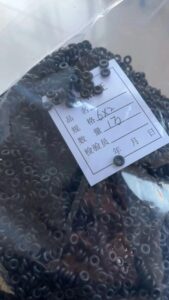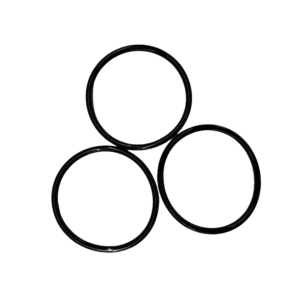Table of Contents
ToggleWhat is an O-ring?
An O-ring is a torus-shaped (doughnut-shaped) mechanical seal made from elastic materials such as rubber, silicone, fluorocarbon (e.g., Viton), or synthetic polymers. Its primary function is to prevent the leakage of fluids (e.g., oils, gases) or contaminants between two mating surfaces. Below is a comprehensive breakdown of its design, materials, applications, and key considerations:


Basic Structure and Function
- Shape: Circular cross-section resembling the letter “O,” designed to sit in a groove between two parts.
- Sealing Mechanism: When compressed within a groove, the O-ring deforms to fill gaps, blocking fluid or gas flow. System pressure can further enhance sealing by pushing the O-ring against groove walls.
- Material: Chosen based on flexibility, temperature tolerance, and chemical resistance. Common materials include:
- Nitrile (NBR): Affordable and oil-resistant.
- Viton/FKM: Resistant to high temperatures, chemicals, and aggressive fluids.
- Silicone: Excellent flexibility across extreme temperatures.
- EPDM: Ideal for water, steam, and weather exposure.
Applications
O-rings are versatile and used in both static and dynamic systems across industries:
- Static Seals: Fixed connections (e.g., pipe flanges, fuel injectors).
- Dynamic Seals: Moving components (e.g., hydraulic cylinders, pumps, engines).
- Key Industries:
- Automotive (fuel systems, engines).
- Aerospace (hydraulic systems, propulsion).
- Industrial machinery, HVAC, and plumbing.
- Notable Example: O-ring failure due to cold-weather brittleness contributed to the 1986 Space Shuttle Challenger disaster.
Variants and Specialized Types
While standard O-rings have a circular cross-section, specialized variants include:
- Square O-rings: Rectangular profile for unique sealing requirements.
- O-ring Kits: Preassembled sets with multiple sizes, materials, or shapes for maintenance or repair.
- Oil Seal O-rings: Designed for hydraulic or engine oil sealing.
- High-Temperature/Chemical-Resistant O-rings: Made from Viton® or FKM for harsh environments.
Key Considerations for Use
- Material Selection: Must withstand operating conditions (temperature, pressure, chemicals).
- Sizing: Proper inner diameter and cross-sectional thickness ensure effective compression.
- Installation: Avoid twisting, pinching, or over-compression to prevent leaks.
Advantages
- Simple, cost-effective, and reusable.
- Bidirectional sealing (blocks leaks in both directions).
- Suitable for static and dynamic applications.
Limitations
- May require backup rings in high-pressure systems.
- Material limitations in extreme environments (e.g., very high temperatures or corrosive chemicals).
Conclusion
O-rings are essential for creating reliable, leak-proof seals in countless mechanical systems. Their performance depends on correct material choice, precise sizing, and proper installation. Whether in automotive engines, aerospace hydraulics, or household plumbing, these small yet critical components ensure system integrity and efficiency.



Leave A Comment